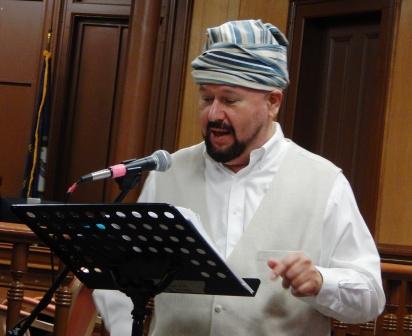 Chief Troy Wayne Poteet, wearing traditional Cherokee headdress, lectures on the Trail of Tears. (Clinton, KY) - When European/Americans decided they wanted land settled by the civilized tribes of the Cherokee and Chickasaw nations, there was little that Native Americans residing there could do to stop them. Cherokees had settled in Georgia, some building fine plantations with African American slaves. Others were of more modest means. The Cherokee believed that an earlier treaty would protect them from being removed. But Andrew Jackson bowed to pressure from Georgians for their removal.
Even a victory at the US Supreme Court by a white supporter of their claim (Indians could not bring suit) was insufficient to hold their claim. Reports that President Andrew Jackson remarked that US Supreme Court Chief Justice John Marshall made a decision - let him enforce him are unproven. Whether he said it or not, he certainly didn't lift a finger to enforce the third branch of government's order. Nothing, not judges, not indigent peoples, would be allowed to interfere with the Manifest Destiny of the new American nation.
What followed was one of the most infamous acts in American history: the Indian Removal Act.
Thousands of Native American households were uprooted and moved west to the Oklahoma Territory in what became known as the Trail of Tears. It is not known how many died of exposure and disease during the forced migration, though probably in the thousands.
The Trail of Tears is history, a history that continues to resonate in the American narrative.
A particular portion of the story has been coming to light in recent years in the area of Kentucky named for Andrew Jackson. One of the several routes taken went through Hickman County led by John Benge who led a group of 1100 Cherokees and their households through Kentucky and across the Mississippi River into Missouri. What is now known as the Benge Trail. The group arrived in Columbus Kentucky in November 1838, camped for a time. Crossing on barges took ten days. The Benge detachment then trekked through Missouri and on to Oklahoma.
Chief Justice of the Cherokee Nation Troy Wayne Poteet told the story of his ancestors' migration to a large audience in Clinton on July 25th. Chief Poteet was in Hickman County to dedicate signs depicting the land and water routes of the Benge Trail.
Cherokees were among the Eastern tribes. They had settled in Georgia, some building fine plantations with African American slaves. Others were of more modest means. The Cherokee believed that an earlier treaty would protect them from being removed. But Andrew Jackson bowed to pressure from Georgians for their removal. According to Poteet, Jackson had faced down famous secessionist Senator John C. Calhoun of South Carolina when he threatened to break up the Union. Jackson, who had some sympathy for their plight, would not risk taking on the Georgians. Besides, Poteet said, there was no assurance that American troops would fight their own over Indian grievances.
Chief Poteet demonstrated how his headdress worked (a long piece of cloth wrapped around and tucked in). The most well known Cherokee Chief Sequoyah wore such a headdress.
The history of the trek will be preserved at the Hickman County Historical & Genealogical Society Building o n South Washington Street in Clinton. Members of the local historical society met with Norma Pruitt, Chief Poteet, Carla Hildebrand, Park Manager of the Wickliffe Mounds State Historic Site, Alice Murphree, shown at right, Trail of Tears Association, Kentucky Chapter President and Cindy Lynch, Park Manager of Columbus-Belmont State Park. n South Washington Street in Clinton. Members of the local historical society met with Norma Pruitt, Chief Poteet, Carla Hildebrand, Park Manager of the Wickliffe Mounds State Historic Site, Alice Murphree, shown at right, Trail of Tears Association, Kentucky Chapter President and Cindy Lynch, Park Manager of Columbus-Belmont State Park.
According to Historical Society secretary LaDonna Latham, "Out of this meeting came the formation of the Chickasaw-Cherokee History Center of the Jackson Purchase that will be housed at the Hickman County Historical Society Building."
If history forgotten is history repeated, the hope was expressed by all those involved in commemorating the Benge Trail is that remembering will guarantee there will never be another Benge Trail. |








